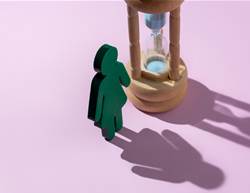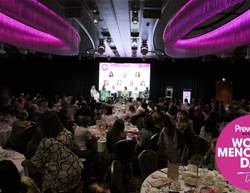For good bone health at and beyond menopause, it is essential not just to eat well, but also to give your bones the benefit of well-planned muscle resistance training.
When bones lift against a higher-than-normal load, this stimulates the action of a class of bone-building cells known as “osteoblasts”. As osteoblasts also work harder in response to oestrogen, the approach of menopause makes regular resistance training a must.
Of course, while some people love going to the gym, for others, putting on Lycra and lifting heavy weights is a complete no-no, especially if menopause is playing havoc with your body shape. Fortunately, there are plenty of ways you can carry out resistance training in your home without needing extra equipment.
Try this resistance workout from The Fast 800 program, based on my books.
Warm-up
We need to get the blood pumping to the muscles that you’ll be using during the workout:
- 30 seconds gentle walking on the spot
- 5 push-ups against the wall
- 30 seconds high knees walking on the spot
- 5 half squats
- 5 lunges and stretch arms above head
- 30 seconds jogging on the spot
The workout
Perform each exercise for 20 seconds (this is called your work period) followed by a 40-second break (this is called your rest period). Repeat the routine 2-3 times.
You’ll need two light dumbbells. If you don’t have any dumbbells at home, use water bottles or tinned food. And if you need the workout to be more challenging, increase your work time and decrease your rest time. For example, you could exercise for 30 seconds and rest for 30 seconds; or 40 seconds of work with 20 seconds of rest.
1. Alternating lunges
Lunges are one of the staple leg strengthening exercises which should be included in any varied workout program.
How to do it: Stand with feet shoulder-width apart, looking forwards and keeping your shoulders back. Take a large step forwards with one foot and lower yourself as low as comfortably possible. Both knees should be roughly at 90 degrees. Raise yourself back up, focusing on using the front leg to do so, stepping back into a standing position. Remember to breathe out as you come back to standing and don’t go too fast: 2 seconds down, 2 seconds up. Repeat the action, stepping forward with the other foot, and alternating for the allotted time.
Tips: Try to imagine you are pushing the floor away from you with your front when returning back to standing. Throughout the exercise, engage your core to remain steady - do this by pulling your belly button in towards your spine. Also, try to keep your chest up, rather than bending your torso forwards.
2. Hip thrusts
This exercise activates your hip flexor muscles and your glutes, as well as strengthening your hamstrings.
How to do it: Lie flat on your back. Bring your feet in towards your bottom so your knees are bent, with your feet slightly apart. Raise your hips by pushing against the floor through your heels so your knees, hips and shoulders are in line, to a bridge position. Exhale as you hold the bridge position for 2 seconds and then inhale as you lower yourself back down to the floor. Repeat for the working time.
Tips: Keep the soles of your shoes on the floor throughout, while also keeping your shoulder blades on the ground. Squeeze your bottom when you raise your hips to maximise tension in the right muscles.
3. Plank
An excellent exercise for developing core strength, the plank will test your mental strength as well as your physical ability.
How to do it: Lie, face down, on your exercise mat. Keeping your knees down, push yourself up onto your elbows, making sure your elbows are positioned slightly behind your shoulders. Lift your knees, keeping your head, shoulders, hips and feet in a straight line. Don’t push your head down and remember to keep breathing! Hold this position for the work time specified.
Tips: If you find this too difficult to begin with, keep your knees down and complete the exercise in this position. Ensuring you create a straight line from your knees, through your hips to your shoulders. Or, do a high plank, where you hold a push up position with your hands under your shoulders and your body creating one long line from your heels to the top of your head.
4. One-arm rows with a chair
Primarily targeting your largest back muscles, your lats, the one-arm row will improve back, core, and bicep strength.
How to do it: With one arm, lean forward against a sturdy chair or arm of your sofa for stability. Keep both legs slightly bent with one in front of the other, hip-distance apart and your shoulders back and level with each other. Hold a weight in the arm on the opposite side to your front leg. Keep the arm fully extended and the palm facing in. Keeping the rest of your body still and stable, raise the weight up towards your body, making sure your elbow remains tight against your body. Your arm should be the only thing moving. Lower the weight back down to the starting position. Remember to exhale as you lift the weight and don’t go too fast - 2 seconds up, 2 seconds down. Repeat the action for the work time specified. Swap arms/sides and then repeat the exercise again on the other arm.
Tips: Keep your back straight throughout the exercise by engaging your core, draw your belly button towards your spine. To maximise the effectiveness of this exercise, squeeze your shoulder blades together when you lift the weight up to the side of your chest.
5. Calf raises with a chair
Calf raises are a great way to isolate the calf muscle and can be performed with or without extra weights.
How to do it: Stand with your feet shoulder-width apart. Rest your fingers on the back of a sturdy chair or table if you need to stabilise yourself while doing the exercise. Push yourself up onto the balls of your feet, trying to keep your body as straight as possible. Hold briefly, squeezing your calves, then lower yourself back down so your feet are flat on the floor. Exhale as you raise yourself up and remember not to go too fast - 2 seconds up, 2 seconds down. Repeat the exercise for the work time specified.
Dr Michael Mosley is a qualified doctor, award-winning science journalist, and founder of online programme The Fast 800.





.png&h=193&w=250&c=1&s=1)



